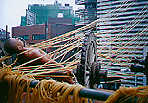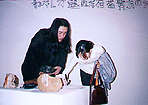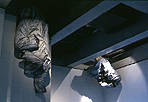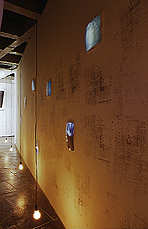
|
|
Jun. 10, 1997
|
Art Watch Index - May 13, 1997
![]()
<<Chinese Contemporary Art 1997>>
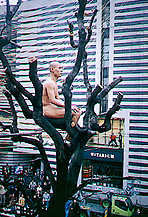
Zhang Huan
Wang Jin
Wang Jin
Chan Yuk Keung
Gao Bo
Zhan Wang
Wang Gong Xing Photo: The Watari Museum of Contemporary Art
WATARI-UM (in Japanese) http://www.cyber-bp.or.jp/ watarium/
The Watari Museum of Contemporary Art
CHINESE CONTEMPORARY ART 1997
The Tiananmen Square incident
The Gate of Heavenly Peace
People's Republic of China: III
Plexus: Tian-Miao Lin
Plexus: Gong-Xin Wang
|
<<Chinese Contemporary Art 1997>>
As we all know, since the '80's, exhibitions of contemporary art from Asian nations have been held frequently by Japanese art musuems, so much so that this trend could even be recognized as a boom. However, not many of them have focused on China. This could be because of the country's enormous scale, but more than anything else, the supressed situation after the Tiananmen Square incident has made the introduction to the public very difficult. Still, with the progress of the open economic policy, information about underground "Chinese avant-garde" activities have been made accessible to the overseas countries, allowing research to be conducted locally to a certain extent. The "Chinese Contemporary Art" exhibition held at the Watari Museum of Contemporary Art in Harajuku, took advantage of that opportunity, and was an exhibition introducing the trend of the young generation of artists in China. There were six artists from Beijing, and one from Hong Kong, and they were all born between the late '50's and the first half of the '60's. In other words, they belong to the "post Tiananmen Square incident" generation. Among this generation are artists advocating a nihilistic attitude called "cynical realism", including Fang Lijun, who held a retrospective exhibition in Japan last year, and also many artists who tackle installations and performances as in this exhibition. Perhaps due to their internal trauma developed from the encounter with the Cultural Revolution and the Tiananmen Square incident during their formative years, they all possess a deep rift between themselves and politics in the real world, and because of this, they may have been forced to pursue their expressions towards a heavy, introverted direction. The confrontation with the age What was important to be noted about this exhibition was that all the artists had come to Japan for the construction of the artworks, the symposiums, and the performances. Especially, the realization of the performance by Zhuan Huan was, indeed, a huge benefit. Actually, I had met him several times last year in Beijing, and when he showed me a video that contained images of him risking his own body, I had thought his work would never be able to leave the country due to its radicalism. In his performance held early morning on April 6th, Zhuan Huan placed a large wooden wheel brought from China on the roof of a building, hung numerous rubber tubes for blood transfusion between that roof and the window of Watarium, also hanging a bell between the two buildings, and kept on rocking the tubes by leaning his naked body on the wheel. It was certainly a heroic scene, in which as if a body carrying a solemn history confronted the contemporary age.
[Akira TATEHATA/Art Critic]
|
||
|
|
|
|
|
|
|
|
Jun. 10, 1997
|
[home]/[Art Information]/[Column]
Copyright (c) Dai Nippon Printing Co., Ltd. 1997
Network Museum & Magazine Project / nmp@nt.cio.dnp.co.jp
